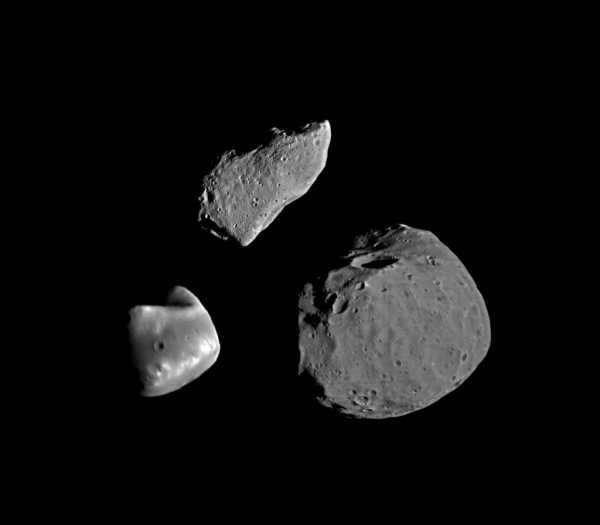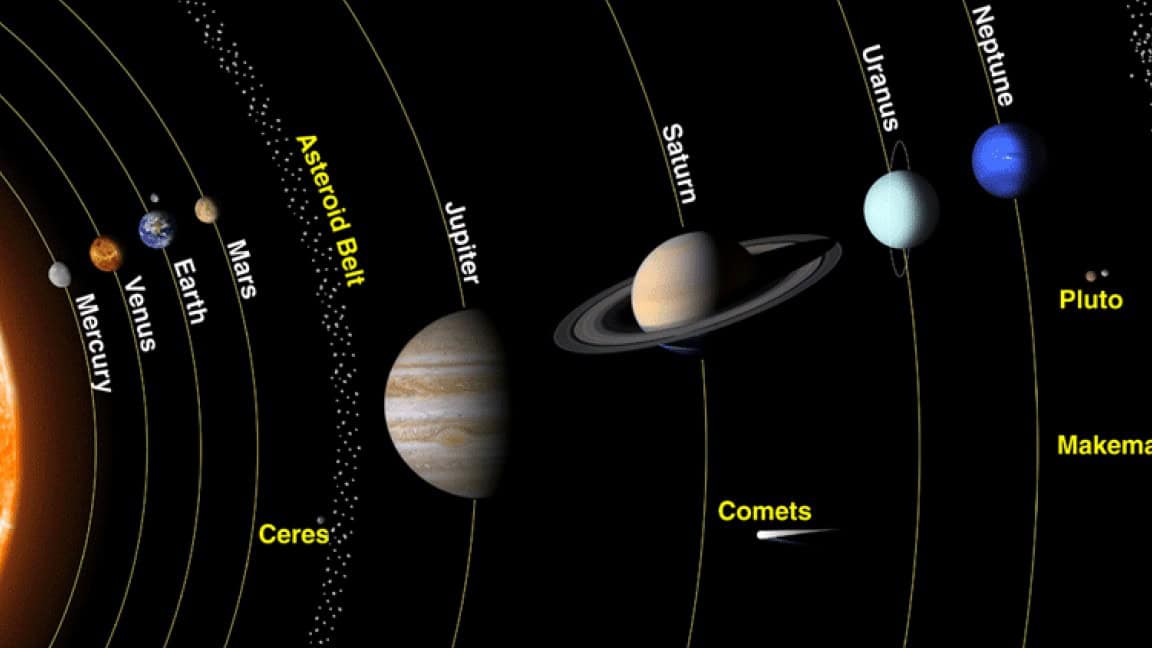When a meteoroid enters the Earth’s atmosphere and incinerates, it is referred to as a meteor. The majority of meteors burn up in the atmosphere before reaching the Earth’s surface. As they travel through the atmosphere, meteors create a luminous trail composed of ionized gases produced by the heating of the meteor. Occasionally, large meteors make it to the Earth’s surface.
A meteor that lands on Earth is known as a meteorite. Meteorites can be discovered in various locations on our planet. They are typically composed of rock and iron. Throughout the year, we might witness several hundred meteors falling during the night. This event is called a meteor shower, which occurs when the Earth passes through a cluster of space debris left behind by a passing comet.

As the asteroid Ida approached, the Galileo spacecraft captured a series of photographs illustrating its revolution around its axis every 4 hours and 39 minutes.
While most space debris consists of dust and tiny grains of sand, there are larger objects that can be as big as small rocks. The larger the particle, the more brightly it burns in the atmosphere. These brightly colored meteors are known as bolides.
Asteroids in the solar system: Is it the apocalypse?
Asteroids that cross the Earth’s orbit present a potential threat to our planet. There are hundreds of these asteroids that have a diameter of several kilometers. Traveling at incredibly high speeds, these celestial objects have the capability to cause catastrophic damage. A prime example is the Barringer crater in Arizona, which was created by the impact of a meteor measuring only 50 meters in diameter.


The combined weight of all the asteroids in the Solar System is smaller than the weight of the Moon.
Experts theorize that the extinction of the dinosaurs was caused by a 16-kilometer asteroid. The impact of this space rock created a 200-kilometer crater on Earth’s surface.
Millions of tons of dust were thrown into the atmosphere, blocking sunlight and causing the death of plants and animals. Vegetation perished first, followed by the animals. Scientists believe that throughout its history, Earth has undergone multiple global disasters triggered by meteorite impacts.
According to numerous astronomers, there are several hundred unidentified asteroids that frequently intersect the earth’s path. Nevertheless, there is no need to be concerned about the potential of a collision with a massive asteroid, as the likelihood of this happening is extremely low. Additionally, with the aid of advanced technology, a massive asteroid can be readily identified and rendered harmless.
Burevestnik-24.
The Most Unique Photos of Russia in 1931 Captured in Color
2 comments
This is an informative article, but there is one aspect that I am not particularly fond of. In the past, Soviet scientific broadcasts often discussed asteroids and comets, emphasizing their abundance in space. However, the likelihood of them actually colliding with Earth was considered to be extremely low, almost negligible. The focus was more on exploring these celestial bodies for the sake of knowledge. In contrast, Western media tends to emphasize the need to explore asteroids as a means of preventing a potential doomsday scenario. They claim that only through significant investments in scientific research can we safeguard our planet. Some even go to the extent of urging individuals to write letters to their respective governments to secure funding for such endeavors.
However, in reality, the chances of a catastrophic collision are highly improbable. The periodic panic that arises is often driven by the desire of Western astronomers to secure funding from governments. It is worth noting that the approach of Eastern astronomers differs significantly from this perspective.
Great article, but there is something I don’t like. In the past, the Soviet scientific broadcast focused on asteroids and comets and discussed their existence extensively, but the chances of them actually crashing into Earth were extremely slim. However, I believe it is important for us to study these asteroids and learn more about them. On the other hand, Western media seems to have a different approach. They emphasize the need to explore asteroids in order to prevent them from colliding with Earth and causing widespread destruction. They claim that only by investing billions of dollars in scientific research can we save ourselves. They even suggest writing letters to the government to raise awareness about this issue. However, I believe that these claims are exaggerated and are simply a way for Western astronomers to secure funding for their projects. It seems like they are using the occasional panic about asteroids to make money.
The origin of the asteroid belt
The majority of planetary astronomers maintain the belief that the planets within our solar system were formed from a planetary nebula, consisting of gas, dust, and ice. These materials came together in a disk surrounding a young star. Within this disk, small dust particles (and ice particles in the colder regions closer to Jupiter’s orbit) merged to form larger entities known as planetesimals. Over time, many of these planetesimals combined to create the planets we see today. This intricate process typically spans approximately 100 million years.
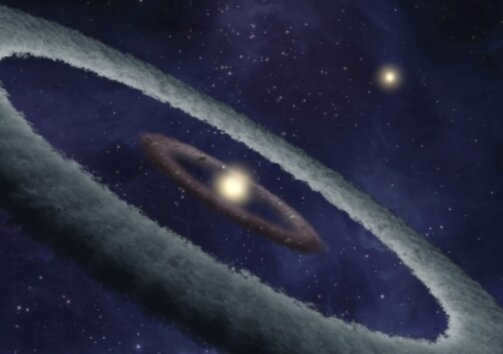
The formation process of main belt asteroids can be attributed to the presence of a gas-dust disk. However, the gravitational influence of Jupiter, which emerged during the formation, hindered the growth of protoplanetary bodies beyond a specific size of approximately 1000 km. Consequently, many of these larger asteroids experienced fragmentation due to collisions and were subsequently expelled to the outer regions of the solar system, such as the Oort Cloud or even beyond. This is how the well-known asteroid belt came into existence.
The structure of the asteroid belt
The majority of asteroids revolve around the Sun within the region known as the “Main Asteroid Belt”, which is situated between the orbits of Mars and Jupiter. This belt is located approximately 2.7 astronomical units away from the Sun. In addition to the Main Asteroid Belt, there are two clusters of icy asteroids that orbit at a distance of 60 degrees ahead and behind Jupiter, known as the “Jupiterian Trojans”. These Trojans include fascinating celestial bodies like the Patroclus and Menoetius double asteroid system. Similarly, there are two comparable objects known as the “Martian Trojans” that orbit around Mars.
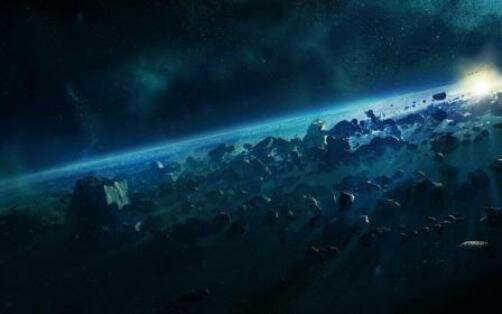
There have been discoveries of asteroids within the orbit of Earth (including in near-Earth space), while some others, known as “Centaurs,” are situated beyond Saturn’s orbit. These Centaurs are actually burned-out or dormant comets that have been expelled from the Kuiper belt due to the gravitational pull of large planets.
It is true that there are numerous asteroids whose orbits intersect with the orbit of Earth. The asteroids in the main belt have the ability to alter their orbit when they collide with other asteroids or comets. Every day, tiny fragments of asteroids known as meteoroids collide with Earth, resulting in meteorites. Additionally, it is speculated that the demise of the dinosaurs on Earth in the past could have been caused by massive asteroids.
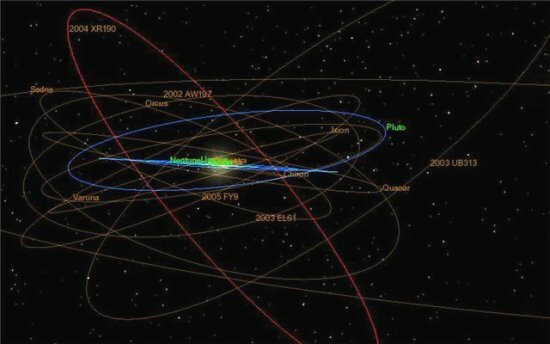

Orbits of certain asteroids
Dimensions of objects in the primary asteroid belt
While the majority of asteroids in the primary belt are the size of small stones, 16 asteroids have a diameter of at least 240 km, and Vesta, the largest of the asteroids, has a diameter of approximately 570 km. In August 2006, the International Astronomical Union decided to establish a new category of objects in the solar system known as “Dwarf Planets”.
The overall mass of the asteroid belt
Small planets might consist of sizable, mostly spherical asteroids like Ceres and potentially Vesta, Pallada, and Hygeia. It has been approximated that the entirety of the primary asteroid belt may be less than 1/1000th of Earth’s mass. In fact, if all the asteroids were able to join forces, the resulting entity would measure a diameter of 1300 to 1500 km, equivalent to one-third to one-half the diameter of the Moon.
Chemical composition of asteroids in the main belt
Based on the analysis of meteorites found on Earth, the majority of asteroids in the main belt are believed to be made up of three main components: primarily silicates (92.8 percent), iron, nickel, and other metals (5.7 percent), and a combination of these materials with carbon-rich substances.
Asteroids that are closer to Mars and Earth, and have similar spectra, are composed of a mixture of rocky minerals and iron. On the other hand, asteroids located farther from the Sun in the main belt tend to have a darker, redder appearance and contain more icy materials. This composition is more similar to the original composition of the dust disk from which the outer planets of our solar system formed approximately 4.5 billion years ago.
Therefore, the outer asteroids might resemble the icy celestial bodies in the Kuiper Belt and the Oort Cloud. It’s possible that larger asteroids or protoplanets have accumulated enough internal heat to cause a separation of the inner layers, with molten dense metals sinking downward to potentially form a metallic core, while lighter rocky remnants have formed the outer layer, known as the crust (for example, Ceres and Lutetia).
In addition, internal heat on certain asteroids can lead to the formation of volcanoes. Although the asteroids in the main belt are quite sizable, they are unable to maintain an atmosphere. However, certain minerals found in meteorites do contain water in a bound state.
The primary asteroid belt is a region in our solar system found between the paths of Mars and Jupiter. It serves as the residence for a variety of objects, known as asteroids or minor planets, which come in all shapes and sizes. This area is commonly known as the main asteroid belt or the main belt, highlighting its distinction from other comparable regions, like the Kuiper belt situated beyond Neptune’s orbit or the collection of scattered disk objects.
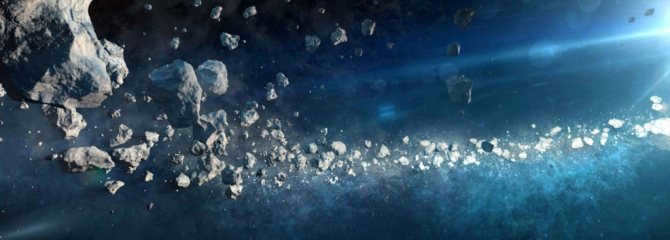
The primary asteroid belt
Astronomers made the initial discovery of the earliest asteroids within the belt during the early 19th century. Presently, the asteroid belt stands recognized by astronomers as one of the most massive assemblages of celestial bodies situated within the solar system. Termed as “minor planets,” these celestial entities exhibit a range in size, extending from several hundred meters to several hundred kilometers. At least 300,000 of these immense rocky objects maintain their own distinct orbits within the solar system’s asteroid belt.
In 1802, an astronomer named Olbers from Germany made an exciting discovery near Ceres. He found a new asteroid and named it Pallada. A couple of years later, in 1804, another asteroid called Juno was discovered, followed by Vesta in 1807. These asteroids have an average diameter of over 400 km. The largest among them, Ceres, is the only dwarf planet in the main belt and has a diameter of more than 950 km. It also has twice the combined mass of Pallada and Vesta. The Asteroid Belt is home to millions of asteroids, but most of them are much smaller, ranging from a few tens of meters in size. Interestingly, the majority of these asteroids are concentrated closer to Jupiter due to the Gas Giant’s strong gravitational pull. Despite the large number of objects in the Asteroid Belt, they are scattered at great distances from each other due to the vast volume of space. This means that one can spend years in the Belt without encountering a single asteroid or comet.
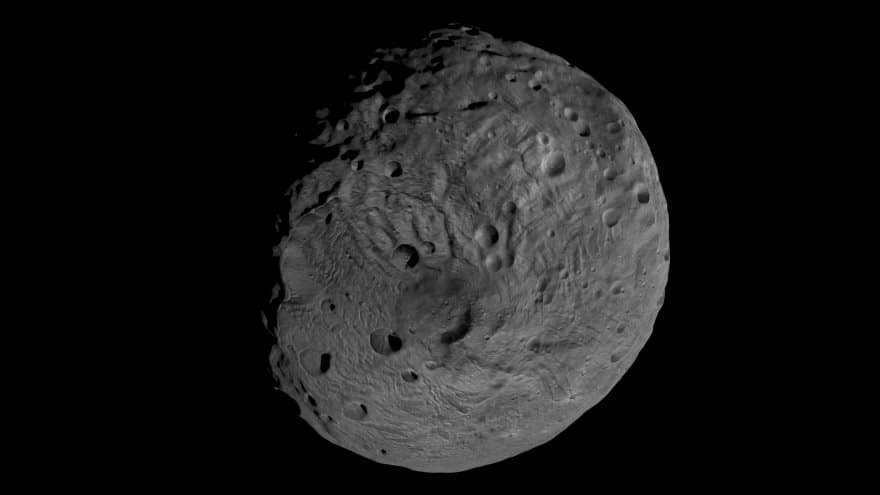
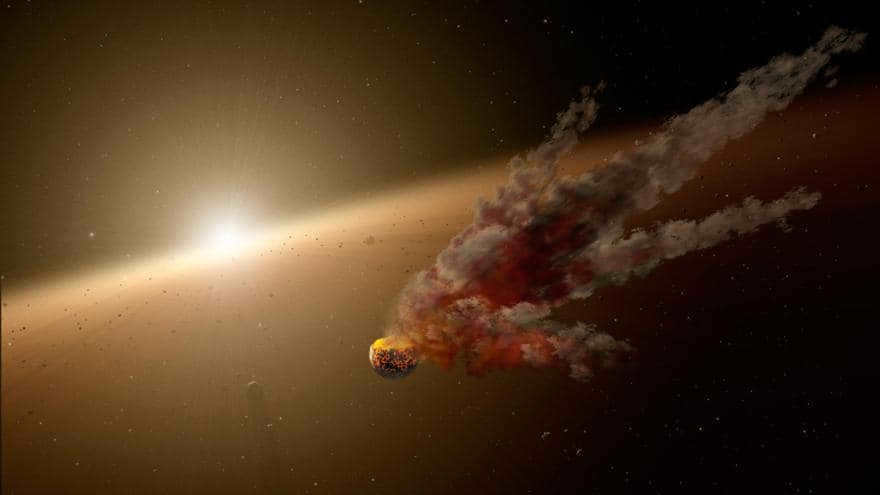
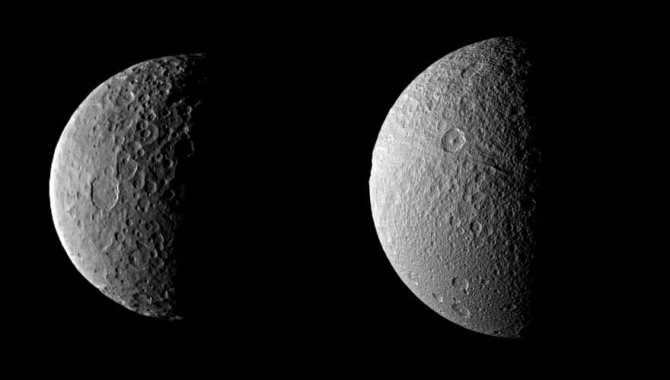
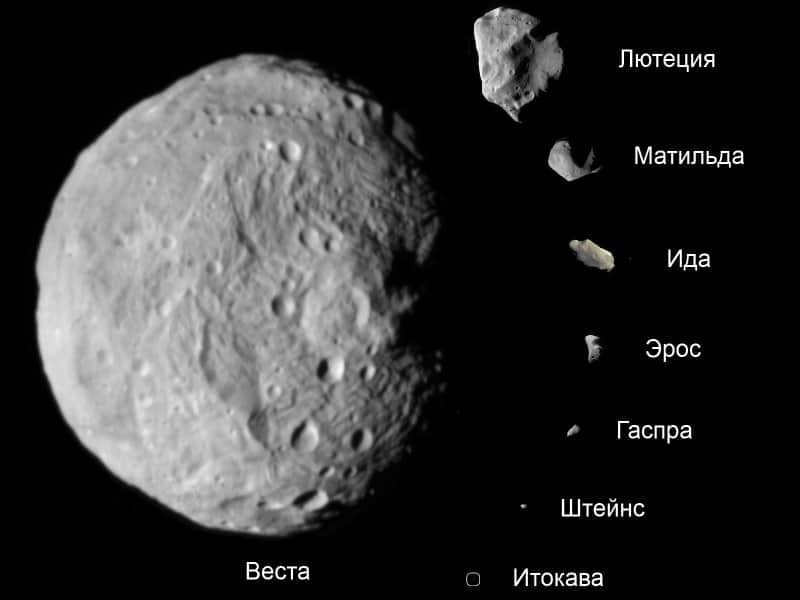
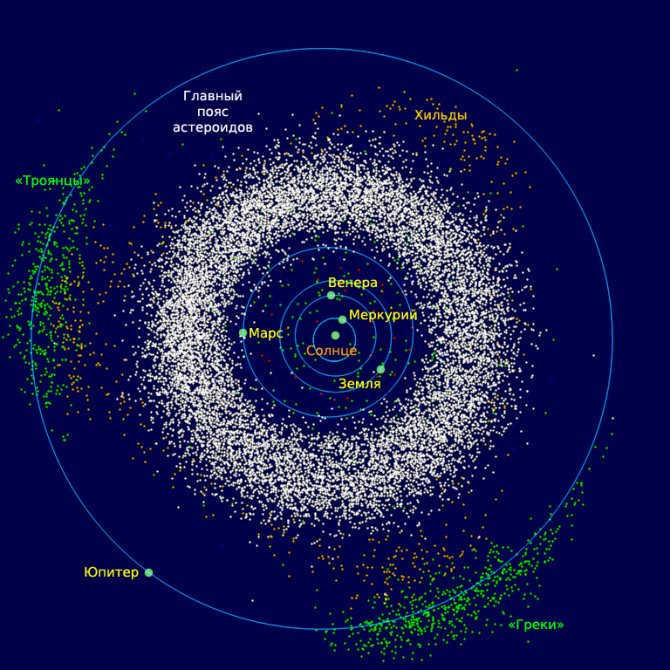
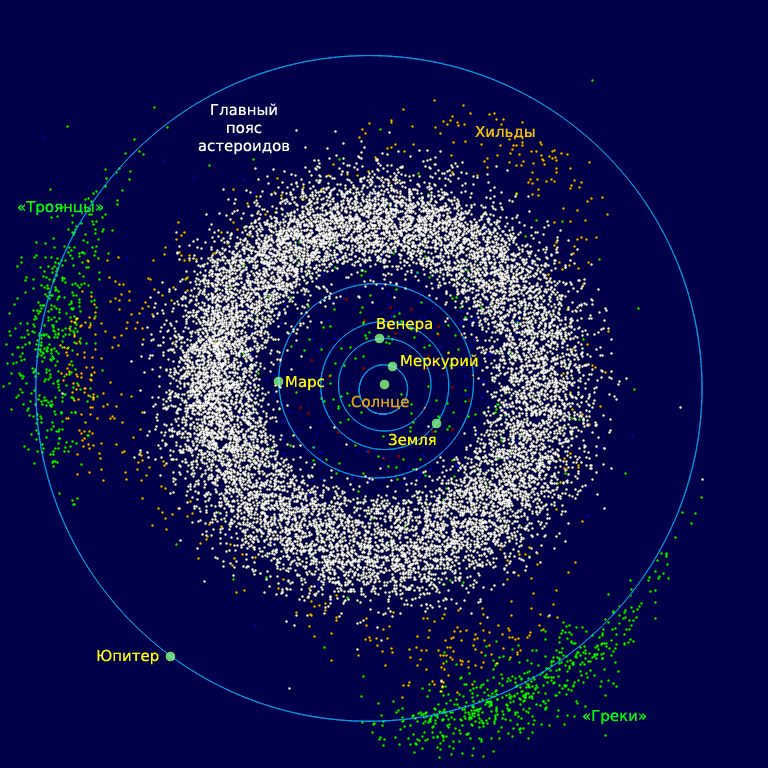
What is the distance to the asteroid belt?
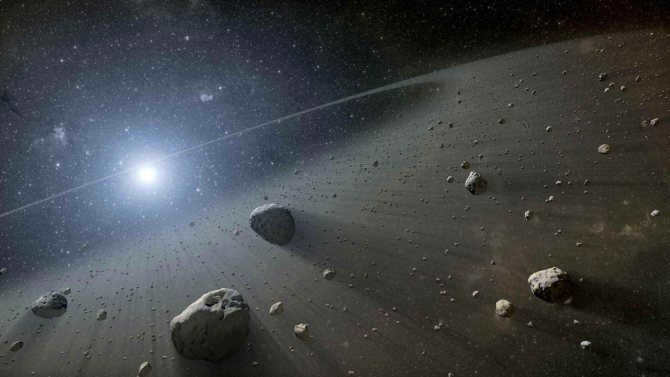
According to the Titius-Bode law, which provides an approximate estimation of the distances between the Sun and the planets, astronomers in the 18th century noticed a significant gap between the orbits of Mars and Jupiter.
As a result of this observation, scientists discovered multiple celestial bodies of different sizes, leading to the term “asteroid” (derived from the Greek word for “star-like”) and the formation of the “asteroid belt” within our solar system. Utilizing various methods and instruments, astronomers have since confirmed the existence of millions of objects located between the orbits of Mars and Jupiter. They have also determined the precise distance of the asteroid belt from Earth.
The structure of the asteroid belt
The asteroid belt is made up of a variety of celestial bodies, ranging from larger objects to countless smaller ones. Approximately half of the total mass of the belt is attributed to the largest bodies, including Ceres, Vesta, Pallada, and Hygeia. Ceres alone accounts for nearly one-third of the combined mass of these four objects. Furthermore, scientists have identified around 200 asteroids with a diameter exceeding 100 kilometers, and an estimated 0.7-1.7 million asteroids measuring at least 1 kilometer in diameter.
According to scientific estimations, the total mass of the asteroid belt ranges from 2.8*1021 to 3.2*1021 kilograms, which is approximately 25 times less than the mass of the Moon. Most asteroids in the belt consist of silicate materials, although a small portion also contains metals like iron and nickel. Additionally, asteroids located farther from the Sun tend to have higher proportions of ice and volatile substances.
Although there are numerous objects present in the asteroid belt, they are widely dispersed. The average separation between these objects is approximately 965,600 kilometers (600,000 miles), indicating that the majority of the main asteroid belt is comprised of empty space. As a matter of fact, due to the sparse concentration of asteroids within the belt, the likelihood of any scientific probe encountering a collision with one is estimated to be less than one in a billion.
The asteroid belt is positioned between Mars and Jupiter and spans a range of 2.2 to 3.6 astronomical units (a.u.) from the Sun, equivalent to a distance of 329 million to 478.7 million kilometers (204,430 million to 297,450 million miles). As a result, the belt’s width surpasses 1 a.u., which is greater than the distance between the Earth and the Sun.
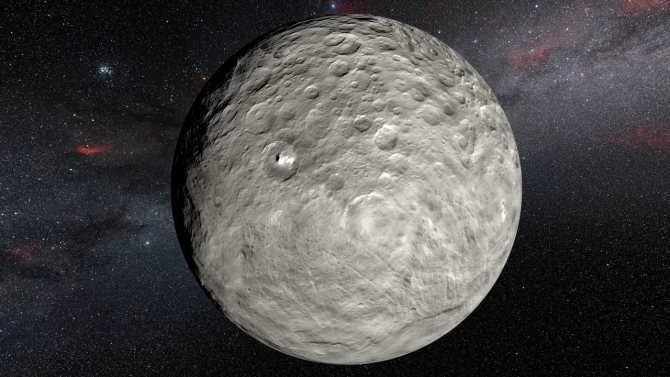
Based on observations made by the Dawn spacecraft (NASA), this illustration depicts Ceres. The authors and rights belong to SO / L.Calçada / NASA / JPL-Caltech / UCLA / MPS / DLR / IDA / Steve Albers / N. Risinger.
The asteroid belt is classified into three zones: zone I spans from 2.06 to 2.5 a.u. from the Sun, zone II covers the area from 2.5 to 2.82 a.u., and zone III is approximately 2.82 a.u. away from the Sun.
Distance from Earth
The measurement of the distance between the asteroid belt and our planet can vary significantly. By considering the average distance from the Sun to Earth and the nearest edge of the belt, we can estimate that the distance falls in the range of 1.2 to 2.2 astronomical units (a.u.), which is equivalent to approximately 179.5 million to 329 million kilometers. However, it’s important to note that the position of the asteroid belt in relation to Earth changes over time, as parts of it can be on the opposite side of the Sun. Taking this into account, the distance between Earth and the asteroid belt can be estimated to be between 3.2 and 4.2 a.u., or around 478.7 million to 628.3 million kilometers.
When planning a mission to explore the asteroid belt, the shortest route is usually chosen, unless there is a specific target asteroid in mind. Therefore, it is generally safe to assume that the distance to the asteroid belt ranges from 1.2 to 2.2 a.u.
The biggest entities in the asteroid belt
It is now customary to classify as asteroids all entities that are at least 1 km in size. Entities smaller than that are referred to as meteoroids. Apart from asteroids, the Belt is home to approximately 20 minor planets (or large asteroids), as well as the dwarf planet Ceres.
Diameter – 950 km. Distance from the sun – 413.9 million kilometers. Similar to the Earth group planets, Ceres has a differentiated composition with a silicate core, an icy mantle, and a thin carbon crust.
Vesta is classified as an asteroid
Diameter – 525.4 km. Distance from the sun – 353.2 million kilometers. It is the brightest asteroid, ranks second in mass, and third in size.
Pallada is a celestial body known as an asteroid
Its diameter measures 512 kilometers. Its distance from the sun is approximately 414.7 million kilometers. Similar to Uranus, Pallada possesses a rather significant inclination of its axis of rotation, which amounts to 34 degrees, while the other three largest asteroids have an inclination angle that does not surpass 10 degrees.
Hygeia is a celestial body
Hygeia is an asteroid with a diameter of 407.12 km and is located approximately 350 million kilometers from the Sun. It is the largest carbonaceous asteroid, making up 75% of all asteroids which fall into this category. Hygeia has an irregular shape.
Asteroids are classified as celestial bodies with a diameter larger than 30 meters, while smaller ones are referred to as meteoroids or meteorites. In the main asteroid belt, there are relatively few large bodies. For instance, there are only about 200 hundred-kilometer asteroids, and approximately a thousand asteroids with a radius bigger than 15 km have been identified. The main population in the main belt is estimated to consist of several million asteroids with diameters ranging from tens to hundreds of meters.
At the dawn of the 21st century, astronomers have knowledge about over 285,000 small planets that reside within the vast expanse of the Great (main) asteroid belt. Furthermore, a considerable number of these celestial bodies are asteroids that range in size from 0.7 to 100 kilometers in diameter. As expected, these entities exist devoid of any atmosphere.
Juno, the asteroid
Diameter – 233.92 kilometers. Distance from the sun – 400 million kilometers. Juno stands as the largest S-class asteroid following Eunomia. Its mass accounts for a mere 3% of the total mass of the largest body within the Asteroid Belt, Ceres.
Antipope is a binary asteroid
Diameter – 87.8 km. Distance from the sun 467 million kilometers. Antiope is a binary asteroid located in the asteroid belt. The two components of the system revolve around a shared center of mass at a separation of 171 km.
From an industrial development perspective, asteroids are considered to be one of the most accessible celestial bodies in our Solar System. Their low gravitational pull makes it easier to land and take off from their surface with minimal fuel consumption. Utilizing near-Earth asteroids for development purposes can significantly reduce the cost of delivering resources from these asteroids to Earth. These asteroids can serve as a rich source of valuable resources, including water in the form of ice, which can be used to extract oxygen for breathing and hydrogen for space fuel. Additionally, asteroids also contain various rare metals and minerals like iron, nickel, titanium, cobalt, and platinum, as well as smaller quantities of other elements such as manganese, molybdenum, and rhodium.
The primary asteroid belt within our solar system
Contributing author: astroson.com 2017-04-19
Researchers have put forward a fresh hypothesis concerning the genesis of the asteroid belt
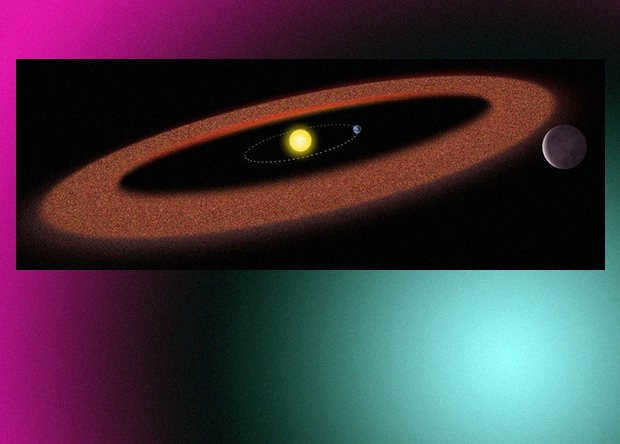
NASA/ESA/STScI
Scientists have proposed a new theory about the origin of the asteroid belt in our solar system. Previously, it was believed that the belt was formed from a planetary embryo that failed to become a planet due to the gravitational influence of Jupiter. However, the new study suggests that there may not have been a planetary embryo at all. Instead, the belt may have formed from the debris of planets in the early stages of their formation. This debris quickly concentrated in a narrow region between Mars and Jupiter, creating the asteroid belt as we know it today. The findings of this study have been published in the journal Science Advances.
A new study by astrophysicists from France and Brazil suggests that the asteroid belt may not have been formed from planetesimals in the gas-dust disk, but rather as a collection of byproducts during the formation of the planets in our solar system. The scientists have observed the diverse composition of the asteroid belt: inner ring asteroids with a silicate composition similar to the Earth group of planets, and outer ring asteroids with a carbon composition similar to the giant planets. This finding leads the astrophysicists to believe that the asteroids may have formed as debris while other planets were forming, and were subsequently pushed into the region between Mars and Jupiter where they currently reside.
Scientists have conducted simulations to test a hypothesis about the formation of Earth-like planets from gas and dust disks. They investigated the possibility of debris planets migrating towards giant planets and clustering in specific areas. The simulations accounted for the gravitational effects of Jupiter and Saturn, including their orbital resonance. By combining the data from the simulations, the scientists obtained insights into the distribution of silicate asteroids. Furthermore, the scientists examined the gas accretion process in gas giants and concluded that it could destabilize their orbits, resulting in the ejection of carbon-type asteroids closer to the Sun.
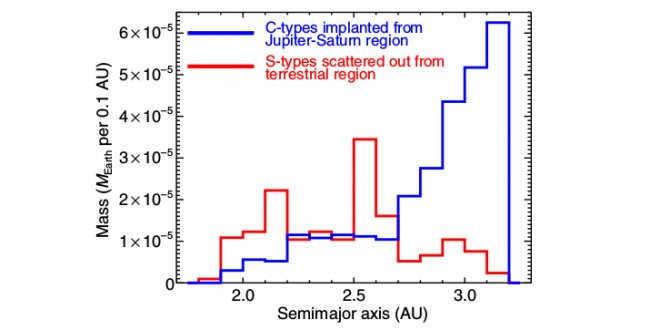
The modeling process revealed the potential arrangement of silicate (S-type) and carbon (C-type) asteroids within the main belt. The study was conducted by S. N. Raymond and A. Izidoro in 2017 and published in Science Advances.
By analyzing their data, the researchers were able to determine the inclination and eccentricity of the orbits of the formed fragments. They concluded that their proposed mechanism could indeed explain the formation of the current asteroid belt. Therefore, it is likely that the asteroid belt initially took shape in its current sparsely populated state, with a small mass and an uneven distribution of composition.
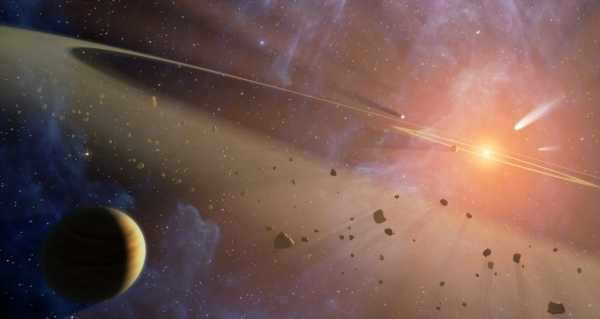
In the artist’s vision, the asteroid belt is depicted as a close gathering of celestial rocks. However, in reality, these rocks are separated by vast distances of hundreds of thousands of kilometers.
Celestial bodies in the solar system that are classified as asteroids are those with a diameter larger than 30 meters. They orbit around the Sun, lack a uniform shape, and lack an atmosphere. It is also possible for asteroids to have their own moons.
Etymology of the term
The term "asteriskos", which eventually evolved into "asteroid", was coined through the collaboration of Charles Burney, an English composer, and William Herschel, a German astronomer. Derived from the ancient Greek language, the word "asteroid" directly translates to "resembling a star". The distinction lies in the fact that unlike planets, which exhibit a disc-like appearance, asteroids appear as mere luminous dots, resembling stars, when observed through a telescope.
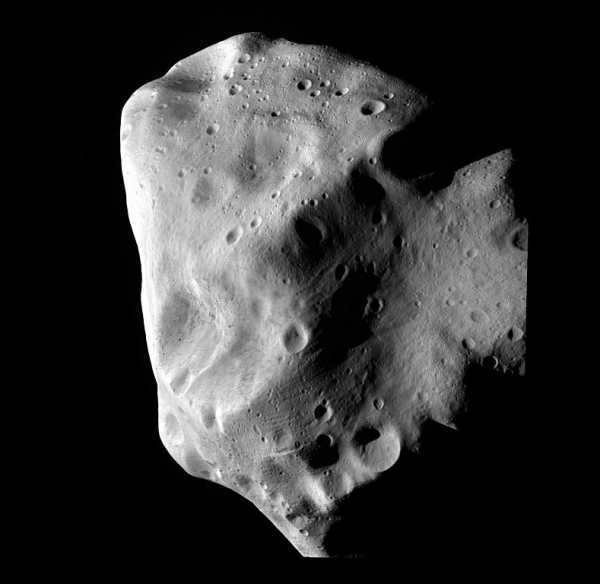
Before 2006, certain small planets like Ceres were also classified as asteroids.
Origin
Asteroids are celestial objects that came into existence through the gravitational attraction between dense gas and dust encircling our Sun during its early formation. Some of these entities, such as the asteroid Lutetia, attained enough mass to develop a molten core. As Jupiter grew in size, most of the planetesimals (potential protoplanets) were fragmented and expelled from the original asteroid belt located between Mars and Jupiter. During this period, a few asteroids emerged as a result of collisions between sizable bodies within the influence of Jupiter’s gravitational field.
Orbit-based classification
Asteroids are categorized according to their orbital characteristics and the reflectance spectrum of sunlight they emit.
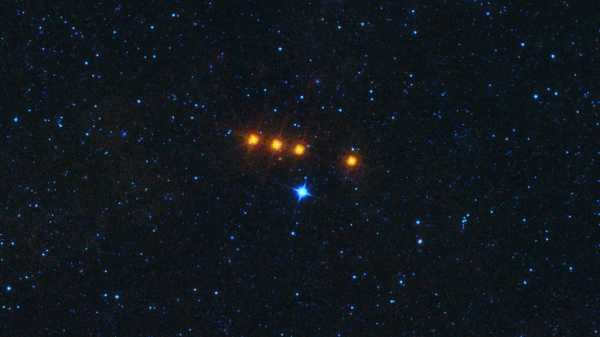
The Ephrosyne family of asteroids is observed in the infrared spectrum.
Asteroids are classified into groups based on their orbital characteristics, and among these groups, families can be identified. An asteroid family is defined as a group of asteroids that share similar orbit characteristics, such as semi-major axis, eccentricity, and orbital inclination. These families are believed to be the result of the fragmentation of a larger body.
The largest asteroid families can consist of several hundred members, while the most compact ones may have around ten asteroids. It is estimated that approximately 34% of the asteroids in the main asteroid belt belong to asteroid families.
Most asteroid groups in the Solar System were formed through the destruction of their parent body, although there are a few groups where the parent body managed to survive, such as Vesta.
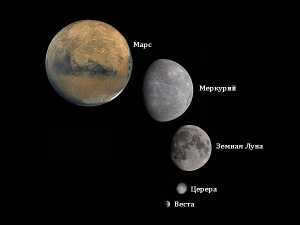
Dimensions of the asteroid Vesta and the dwarf planet Ceres
Spectral classification
Spectral classification is determined by analyzing the electromagnetic radiation spectrum produced when sunlight reflects off an asteroid. By examining and interpreting this spectrum, scientists can determine the composition of the celestial object and assign it to one of the following classifications:
- The S-group, also known as silicon asteroids, is a collection of asteroids primarily composed of iron, magnesium, and various stony minerals. These rocky asteroids have a relatively high albedo, making them visible with binoculars. One example is Irida. Silicon asteroids make up about 17% of the total number of asteroids in the solar system and are most commonly found within 3 astronomical units from the Sun. The largest members of the S-group include Juno, Amphitrite, and Herculina.
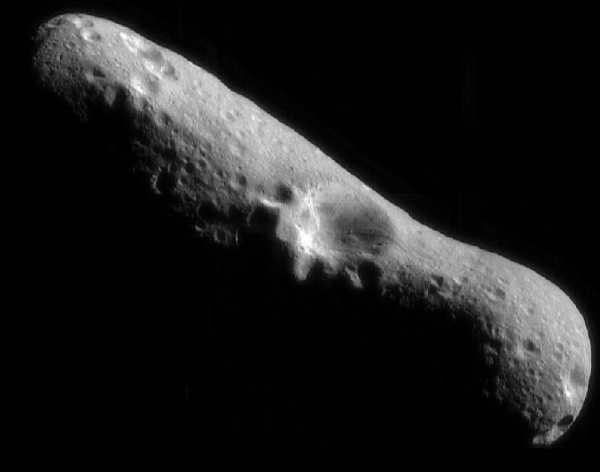
Eros is a prime example of S-class asteroids.
- Iron asteroids or X-group is a category that remains largely unexplored. These asteroids are less prevalent in the solar system compared to other spectral classes. The composition of these celestial bodies is still not fully comprehended, but it is known that many of them contain a significant amount of metals like nickel and iron. It is hypothesized that these asteroids originated from the cores of protoplanets formed during the early stages of the solar system’s formation. Their albedo values can vary, ranging from high to low.
Large asteroids
The largest asteroid in the asteroid belt is called Ceres. Since 2006, it has been classified as a dwarf planet. Ceres has a spherical shape and is composed of a crust made of water ice and minerals, with a rock core.
Asteroid Pallada, which has a diameter of 532 kilometers, is known for its high silicon content.
Vesta, the heaviest asteroid, has a diameter of 530 kilometers. It has a core made of heavy metals and a rocky crust.
Hygeia is the most common type of asteroid with carbonaceous content, and it measures 407 kilometers in diameter.
Interamnia is a rare F-class asteroid with a diameter of 326 km.
Europa has a diameter of 302.5 kilometers and an elongated orbit. It features a porous surface.
Asteroid David has a diameter ranging from 270 to 326 kilometers.
Asteroid Sylvia has a diameter of 232 kilometers and is known to have at least two satellites.
Asteroid Hector has a unique shape similar to a peanut, measuring 370 × 195 × 205 km. It is composed of a combination of rock and ice.
Asteroid Euphrosyne has a size ranging from 248 to 270 km.
Discovery of Asteroids: A Historical Overview
In 1766, Johann Titius, a German mathematician, formulated an equation that allowed for the estimation of the radii of planetary orbits within the solar system. The validity of this equation was subsequently confirmed when Uranus was discovered in 1781, with its orbital radius aligning closely with the predicted value. This success prompted the formation of a group of astronomers dedicated to the search for a planet located between Jupiter and Mars.
It was during this search that astronomers stumbled upon numerous celestial bodies that did not fit the criteria of a planet. Among these intriguing objects were asteroids like Pallada, Juno, and Vesta. Interestingly, the first asteroid to be discovered was Ceres, which was not found by any of the astronomers in the aforementioned group. Instead, it was Italian scientist Giuseppe Piazzi who made this groundbreaking observation.
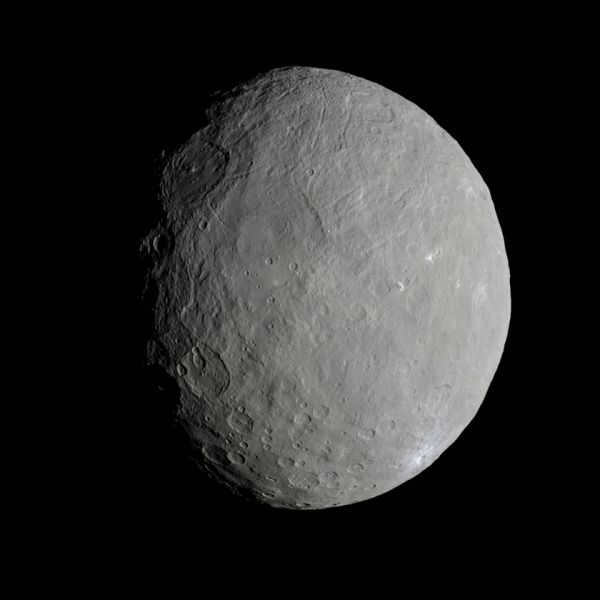
After their unsuccessful quest for a planet situated between Jupiter and Mars, astronomers relinquished their pursuit. However, in due course, the asteroid belt started to captivate an increasing number of scientists, resulting in the current knowledge of over 670,000 asteroids, with 422,000 having been assigned their own designated number and 19,000 having been bestowed with names.
Asteroid exploration in the present era
There are essentially two primary motives for engaging in asteroid research. The first is to make a significant contribution to fundamental scientific knowledge. Through such research, humanity gains valuable insights into the structure and formation of the solar system, as well as the behavior of the universe and its constituents. Astronomers are diligently investigating the composition of asteroids to unravel their true essence. However, the aforementioned reasons do not offer a concrete understanding of the advantages associated with studying these celestial bodies. Thus, let us illustrate this with the following instance.
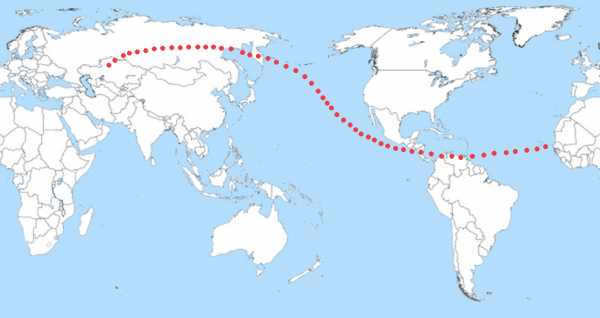
Possible landing locations of Apophis, the asteroid that poses the closest threat to Earth’s orbit.
The hypothesis for the emergence of water on Earth in its modern terrestrial conditions suggests that it was initially too hot for water to exist on the planet’s surface as it cooled. Previously, it was believed that water was later delivered by comets, but recent studies have shown that the composition of comet water differs significantly from Earth’s water. However, in 2010, researchers discovered the presence of ice on Themis, one of the largest asteroids in the main belt. This finding suggests that water may have been brought to Earth by asteroids. Additionally, hydrocarbons and certain molecules were also found on Themis, which could have played a role in the development of life on our planet.
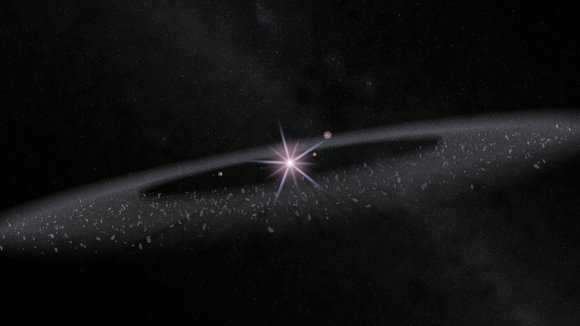
The region between the paths of Mars and Jupiter in outer space is known as the asteroid belt.
The area of asteroids located between the orbits of Mars and Jupiter.
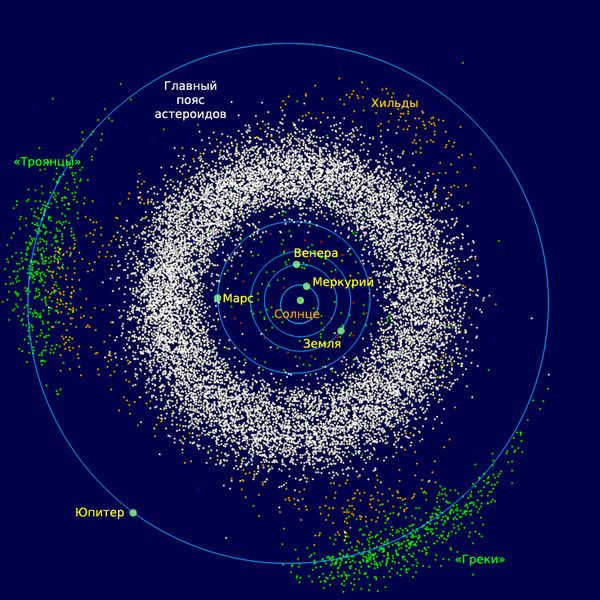
Astronomers first detected the initial asteroids within the belt in the early 1800s. Presently, the asteroid belt is recognized by scientists as one of the most extensive assemblages of celestial bodies in our solar system. This region holds significant scientific value for many researchers.
Asteroid Belt: an overview
The asteroid belt currently contains over 300,000 officially named objects. As of September 6, 2011, there were a total of 285,075 named asteroids within the belt. The most prominent formations within the asteroid belt are named after Roman gods and goddesses such as Ceres, Vesta, Pallas, and Hygeia. Ceres, the largest celestial body within the belt, is classified as a dwarf planet by scientists – more details on this can be found below.
All asteroids discovered since 1980
While scientific exploration and investigation have played a crucial role in understanding the asteroid belt, its origin and significance can be traced back to ancient myths and legends.
During our school years, many of us had dreams of becoming intrepid explorers of outer space. We were captivated by the idea of distant galaxies and planets that we longed to visit. One of these planets was the enigmatic Phaethon, a once-great but now lifeless world.
The legend of Phaethon is vividly recounted in Alexander Kazantsev’s book, “Phaetons”. This book tells the tale of how the greedy inhabitants of Phaeton, known as the Phaetians, destroyed their planet by detonating it, causing it to fragment into innumerable small pieces. It is believed that these fragments are what make up the asteroid belt we see today. A similar account of this cluster of celestial bodies can be found in ancient Sumerian myths and legends.
While myths and legends have their own charm, it is always interesting to explore what science has to say about the origins of the asteroid belt.
Unraveling the Mystery of the Asteroid Belt
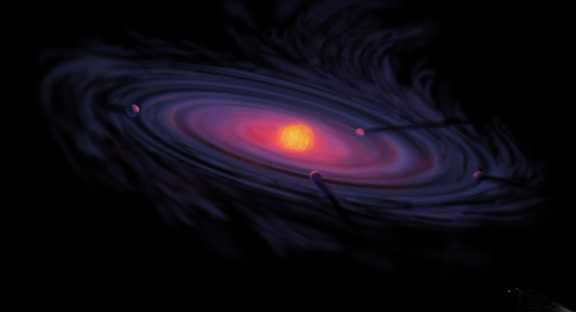

An artistic representation of a protoplanetary disk around a star.
In contrast to ancient fairy tales, the scientific community widely agrees that the asteroid belt is not the remnants of a shattered planet, but rather a collection of protoplanetary material. Recent data supports this theory, indicating that a planet could not have formed between Mars and Jupiter. This is due to the strong gravitational pull of Jupiter, which prevented the protoplanetary material (cosmic dust that forms planets) from coalescing into a complete celestial body at such a great distance from the Sun.
Research on meteorites
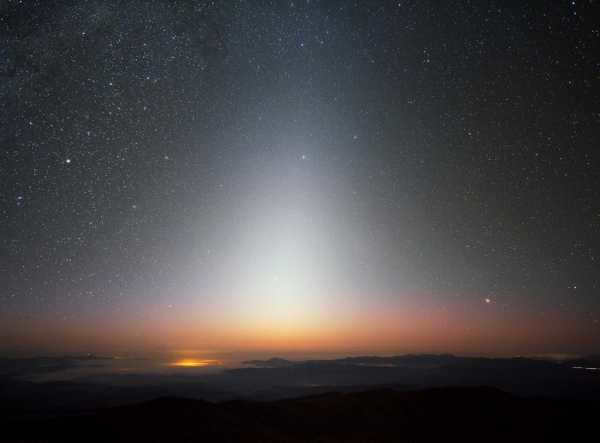
The phenomenon known as zodiacal light is caused by the fine dust produced from asteroid collisions in the asteroid belt.
Research on meteorites that originate from the asteroid belt and land on Earth indicates that the majority of them are chondrites. Unlike achondrites, chondrites do not undergo substance separation, which is a common occurrence during planet formation. These scientific studies provide further support for the aforementioned hypothesis, which is based on empirical evidence and appears to be more credible than the narrative presented in Sumerian myths.
Today, scientists have a clear understanding that the asteroid belt is not merely a fictional, shattered planet, but rather the remnants of protoplanetary material that formed during the early stages of the solar system’s formation. Nonetheless, the enduring myths and legends surrounding the mythical Phaeton continue to captivate people worldwide, fueling their interest in this astronomical phenomenon known as the asteroid belt.
The asteroid belt’s discovery
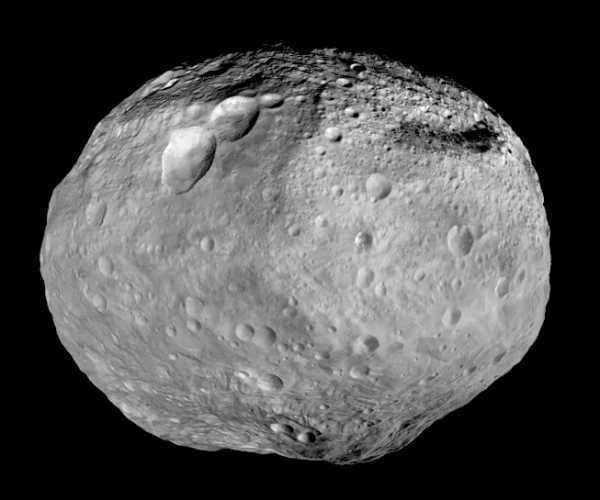
The German physicist Johann Titius was the first to contemplate the existence of the enigmatic planet Phaeton. In 1766, he derived a formula that allowed for the approximation of the locations of all the planets in the solar system. The crux of this formula was that the ordinal distance of the planets from the Sun increases in a geometric progression. It was through the utilization of this formula that Uranus was discovered in 1781, which convinced numerous scientists of the validity of the law of interplanetary distance.
In accordance with Titius’ rule, there ought to be a planet positioned between Mars and Jupiter.
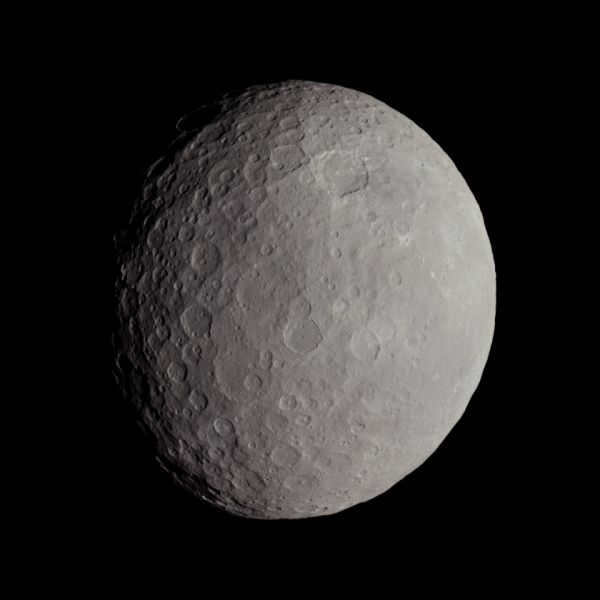
Ceres, an image from the interplanetary probe Dawn
Italian astronomer Giuseppe Piazzi made a groundbreaking discovery on January 1, 1801 when he spotted the first celestial object in the asteroid belt – the dwarf planet Ceres. A year later, another significant find was made with the identification of the asteroid Pallada. These two cosmic bodies shared a similar orbit, approximately 2.8 astronomical units from the Sun. The discoveries continued in this region of space with the detection of Juno in 1804 and Vesta in 1807, both of which moved along the same orbit as their predecessors. However, it wasn’t until 1891 that the next wave of findings occurred. Using the innovative technique of astrophotography, German scientist Max Wolf single-handedly discovered 248 small asteroids between Mars and Jupiter. From then on, the discoveries in this part of the sky came thick and fast.
Latest studies on the asteroid belt
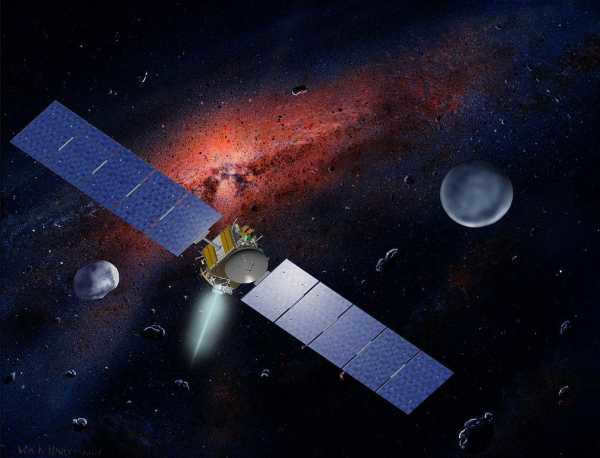
The mission to Vesta and Ceres by the Dawn spacecraft has attracted the attention of scientists not just in the past centuries, but also in recent times. The flight of the Pioneer 10 spacecraft, which was primarily designed for the exploration of Jupiter, marked a significant technological breakthrough in the study of the asteroid belt. This spacecraft became the pioneer in traversing through the asteroid belt and has since been followed by nine other spacecrafts. Remarkably, none of these spacecrafts encountered any collisions with asteroids during their journeys.
Spacecraft flybys
Astronomical bodies pass near spacecraft
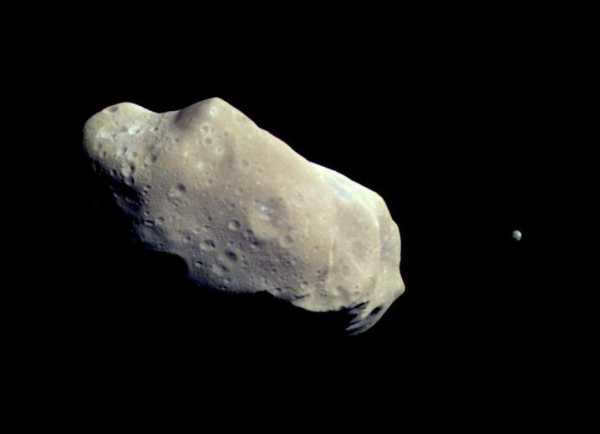
The Galileo space station was the first to capture images of asteroids. In 1991, it photographed Gaspra and in 1993, Ida. Once NASA obtained these images, they determined that any spacecraft passing near the asteroid belt should try to capture photos of these objects. Since then, various spacecraft including NEAR Shoemaker, Stardust, the renowned Rosetta, and others have come close to asteroids.
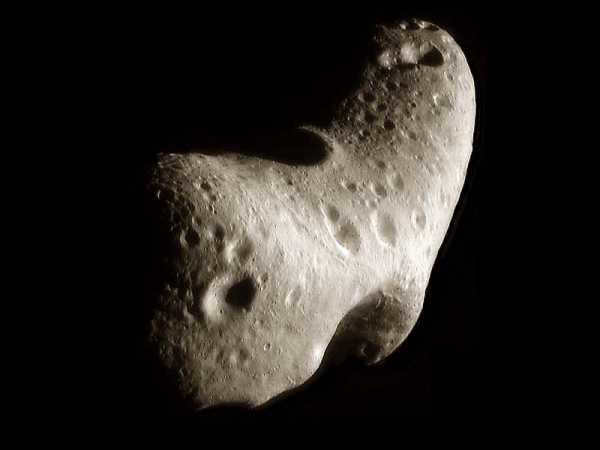
A composite image has been created to showcase the north polar region of the asteroid Eros.
The biggest objects found in the asteroid belt
Among the notable objects in the asteroid belt, the following are considered to be the largest:
– Ceres, which is classified as a dwarf planet, measures approximately 950 kilometers in diameter at the equator.
– Pallada, an asteroid, boasts an estimated diameter of 532 kilometers.
– Vesta, another asteroid, has a diameter measuring 529.2 kilometers.
– Hygeia, also an asteroid, has a diameter of around 407.12 kilometers.
All of these items are found within the main asteroid belt, which is typically referred to when discussing the asteroid belt as a whole. This region is home to the largest concentration of asteroids and is situated near the planet Mars.
Composition of the asteroid belt
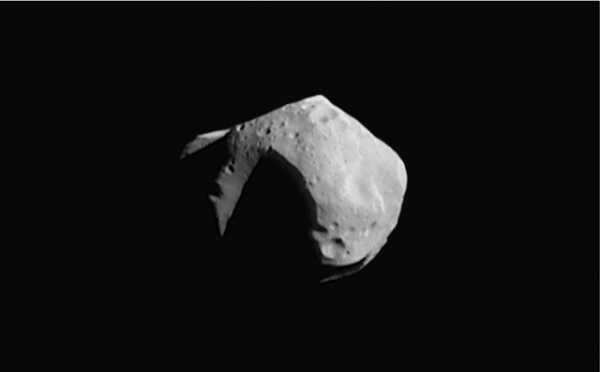
Image of asteroid (253) Matilda
The primary components of objects in the Asteroid Belt are rocky and/or metallic. Research indicates that a significant number of the celestial bodies in the asteroid belt fall into the Class M asteroid category. The composition of these objects is not well understood, although there is evidence suggesting that they are predominantly composed of metallic materials. Furthermore, it is possible that certain objects within the asteroid belt may contain water, raising the hypothetical possibility of discovering signs of extraterrestrial life on one of these bodies.
